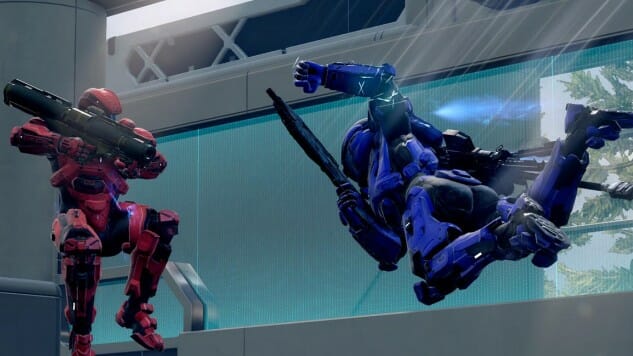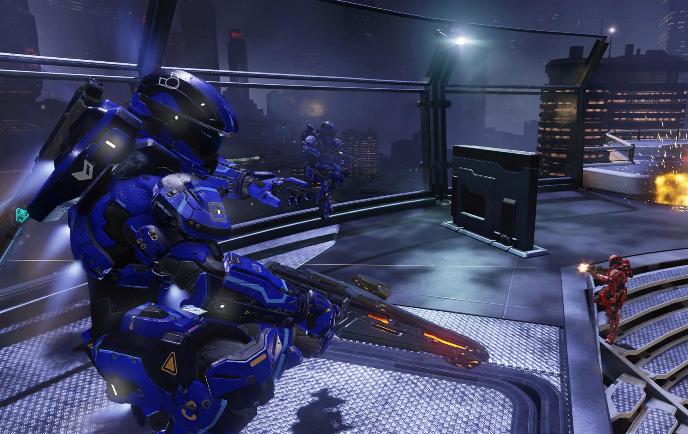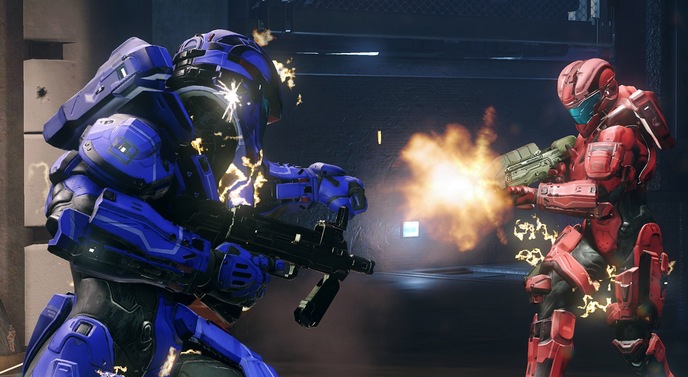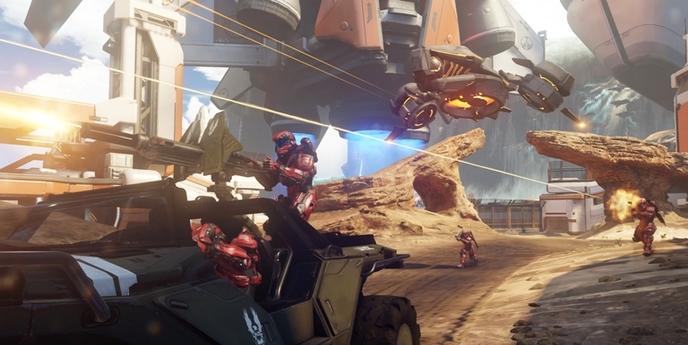
Earlier this week we reviewed Halo 5’s single-player campaign. Now that we’ve had time to experience the multi-player on public servers, we finish our review of Halo 5.
In broad terms, there’s two ways of reviewing any multiplayer experience. The first is that you can talk about the mechanical nature of that experience. You can explain weapon reload timings, the downtime between ability uses, the variety and structure of arenas, the best engagement tactics for given conditions, and anything else that boils down to explaining how each piece moves in the game of chess. The second is that you can talk about the emotional nature of that experience. How do these elements make you feel, and more importantly, when other people access these elements at the same time, how do your combined actions make you feel?
I’m increasingly interested in this second mode of evaluation. The emotions that a multiplayer game facilitates within a group of people through its design makes or breaks my desire to play a game, full stop. When Heroes of the Storm creates a readout where every player can evaluate the individual contributions of each of their team members during the match, it creates a system where a short-term downswing in performance can become a site for bullying. When Destiny’s loot system creates objective optimal loadout choices where a player can be rejected out of hand for not having made those choice, it does the same.
I honestly believe that evaluating Halo 5: Guardians’ multiplayer mechanics and afforded emotions alongside one another is the only thing that’s left, as this review will demonstrate, because the only thing left to say about the Guardians multiplayer is that it is a Halo multiplayer experience.
If you’ve played a Halo game’s multiplayer mode, you’ve played every Halo multiplayer mode to some degree. While there are an extreme number of small changes, the broad strokes are so broad as to constitute a genre all of their own. You control a space marine who has an overshield with quite a bit of health that can be taken down via damage from enemy weapons. That overshield regenerates after a short time of inaction, and if you’re shot while it is down you will more than likely die. Some weapons destroy that shield quickly, like grenades, but every weapon is going to eat through the shield really fast if you’re being shot in the head.
The game is completely balanced around this regenerating shield. Your move speed, your jump height, and your ability to use a button to dash a short distance are all gauged around how likely it is that someone would be able to shoot you for a sustained amount of damage before you can run, jump or dash away. When you’re trapped out in the open, it feels profoundly unfair. When you’re in tight corridors, a relative rarity in Halo design, you might be able to dodge around. In general, if you’re being shot for more than 1/10th of a second, you’re probably going to have to respawn in a few seconds.
Halo 5 is positioned as a game moving toward the edges of the Halo combat genre. A player who was chatting in a game I played put it succinctly, saying that he loved the game because it was the “perfect” combination of Halo and Call of Duty shooter mechanics. While that might be overstating things, Halo 5 is undeniably borrowing design elements from other shooters in the contemporary scene, including Advanced Warfare and Destiny. The ability to do a damaging forward dash, a “ground pound” dash into the ground, and to aim down the sights of your weapon creates a feeling that there is a wide range of abilities for your previously generic Spartan to do. While the Halo games have used class abilities in the past to enable different playstyles, the franchise is still very much anchored in the shooter mechanics of the 1990s and early 2000s in which the real differences between players were not decided in loadout choice but rather through map knowledge and developed skill.
The Call of Duty multiplayer combat since Call of Duty 4 has relied on a lot of player knowledge about the tuning of the games systems. Having knowledge of the maps, character jump heights, and animation timings are important in that game, but just as important is knowing that there are certain items and weapons that equate to hot garbage. The playerbase quickly figures out what the best statistical loadouts are, and those few weapons become the finite selections for players who are even semi-serious about playing the game. You create your loadout, you play that loadout, and you can generally excel against the general field of players. When I handed the controller over to a friend who hadn’t played any of the Halo games, he pretty quickly decided to play another game. “It seems like it’s a game for Halo players,” he said before turning to a game he thought was a little more welcoming to new players: Metal Gear Online.
Halo 5 steadfastly holds onto a kind of Unreal Tournament style of combat in most of its playlists. Everyone starts with the same weapons, and through building knowledge about the game you can plot the best routes to the best weapons pickups. There’s no pre-planning on what kind of build you might go for other than what the level itself will provide you with. It’s a pure meritocracy out there in the killing fields, and for better or for worse that’s what you’re left with.
In team-based Arena playlists, it makes for decent play. Your team ends up having specialists (someone will have the scattergun; another will camp the sniper rifle spawn). Each person, without external communication, can generally figure out what other people are doing and respond in a helpful (or blockading) way. On a mechanical level, the game feels balanced around these team deathmatch, point capture and capture the flag modes. The power level of weapons never gets out of hand, and with there being such a hard focus on a “goal,” there’s very little room for people to break off into shards. When you have a team even vaguely in concert, it feels good to play. If people are on voice, they chat idly.
On the exact other end, the free-for-all format where players all hunt one another is the ultimate feel-bad place. I genuinely do not understand anyone who enjoys that experience above others. It is a pure demonstration of game, weapon and map mastery, and it feels more like a tool for showing off on YouTube with than it does an actual game format. None of the maps seem balanced to it, and it only generates a miasmatic black cloud of bad feelings for me.
I enjoy my time in these Arena playlists, but deep in my heart I have the exact same feeling about these as I did the campaign. Halo 5 has a ranking system for your skill at each playlist, and the first two I qualified for put me in Platinum and Silver respectively. Without touching a Halo game in literal years, I was able to call on the skills that I began developing an entire decade ago to automatically place me ahead of other people in the game. We’ve been given the same set of experiences over and over again in a multiplayer system that privileges developed player skill over anything else. The past few days of playing this game have been lackluster, feeling more like I was doing due diligence than having fun, and it took the writing of this piece to realize that it’s boredom from having played this exact same game for ten years. I’ve been watching people crouch their crotches into my face for a tenth of a century. Why does this exist, why does it keep getting passed down, and why hasn’t this franchise moved beyond the same rote set of actions and responses in all of this time?
The Warzone mode is this game’s attempt at invigorating the format. It is a giant battleground where two large teams compete to control points and kill certain boss enemies while not losing those points that they’re trying to control. It’s Battlefield-esque, and it creates really interesting 10 or 15 person fights that stretch into cramped rooms, garages and large outdoor arenas. Contrary to literally everything I wrote above, this game mode leans heavily into changing what each player is able to bring into the game when they respawn from death, and this is accomplished through the Requisition system.
Requisitions operate in two parts: their use in Warzone and their use in the larger experience of the Halo 5 multiplayer in general. The former is fairly simple. You collect Requisitions (I’ll explain how in a moment), and when you respawn in Warzone you are able to equip yourself with better-than-Assault Rifle weapons. Depending on which Requisitions you have, you can get any weapon in the game as far as I can tell. Beyond that, you can also summon every vehicle in the game for maximal “here comes the cavalry” experiences.
You get Requisitions in packs, and you can get those in two ways. You can get them when you level up in the appropriately-grindy Multiplayer Leveling System that measures both generic gained experience and specific commendation accomplishments like “Killed 100 Spartans.” The other way you can get those packs is by buying them either with in-game currency or with cold, hard cash. Opening the packs gives you an assortment of common, uncommon and rare Requisitions alongside things like weapon skins, armors, character stances and other cosmetic items. You can “sell” these things back to the game for currency or hang onto them for use in Warzone mode.

Of course, the pack prices are low enough (the most expensive is $2.99) that you can imagine that there are already iTunes Store levels of overspending going on, and I cannot imagine that the publisher has any issue with predatory microtransaction tactics being deployed on the users of this game. It has money-maker all over it: randomized packs, chase rare cosmetics and conditions where paying to win by having better guns at hand at all times is going to seem like the only option for people. It feels gross.
Squeezing customers for cash aside, does Warzone and its Requisitions actually invigorate the game? I can’t say that it does. In fact, it seems like it breaks that core “skill matters” concept in half. Most of my deaths in the mode so far are just due to being ganged up on by a team who is better equipped earlier in the game than I am, whether that is because their team is further along in the tech tree or because they’re actually burning their Requisitions. More than that, vehicles seem to be radically lopsided in their usefulness. A quick-moving Ghost can dominate due to its ability to get away from the large damage output from a team, but any of the tanks or a Banshee is functionally a sitting duck that needs to be protected at all times. Most of these big ticket items still seem balanced (at maximum) with the idea that it is dealing with X damage output, but Warzone warps all of those numbers sheerly through the amount of people who are able to throw a grenade at one time.
All of these complaints and qualms aside, it’s fun to play. I don’t have the patience for longform play like I do with some other multiplayer games, and I think that it’s largely to do with where I sit in relation to this game. The mechanics are too familiar, and the emotions generated from the game are either pure apathy or a grim anger at the balance between the way space is arranged and how meaty-then-fragile the Halo character has always felt. Those emotions are baked into the format, and I recognize them as old friends by now. When the game is doing something new feeling, like the level design of the excellent “Plaza,” I get jazzed up and excited. But when it isn’t, or when it’s leaning into that classic “big arena with some stuff in the way sometimes” like the map “Truth,” I’m shaking my head.
The other night when I was playing, there were two men talking over voice chat. The other team, short of one person, had left mid-match, and these two guys were just kind of shooting the shit as we ran around. The first guy started talking about how much he wanted the new Xbox Elite controller, and the second guy said that he wasn’t interested because of how expensive it is. First guy kept extolling the virtues of the controller. Second guy kept saying yeah, but naw. The first guy finally reaches the point where he just says, “I don’t know, I just….I just want it.” It was immediately apparent that his reading of the feature list, his economic comparisons, and his claims to its importance were all under that generic consumptive need. He just wanted it.
I feel like the second guy when it comes to the multiplayer for Halo V. It exists, and it’s for some people, and I’ll dip into it sometimes if I’m bored. But I can’t commit, can’t make the emotional buy-in, because I just don’t see the point. The people who need a graphical update to the same map design and multiplayer modes that we’ve had for a decade? I think they just want it. I don’t think I do, and if you don’t have that consumptive urge in your heart, I’d suggest trying something else.
Halo 5: Guardians was developed by 343 Industries and published by Microsoft. It is available for the Xbox One.
Cameron Kunzelman tweets at @ckunzelman and writes about games at thiscageisworms.com. His latest game, Epanalepsis, was released on May 21. It’s available on Steam.

